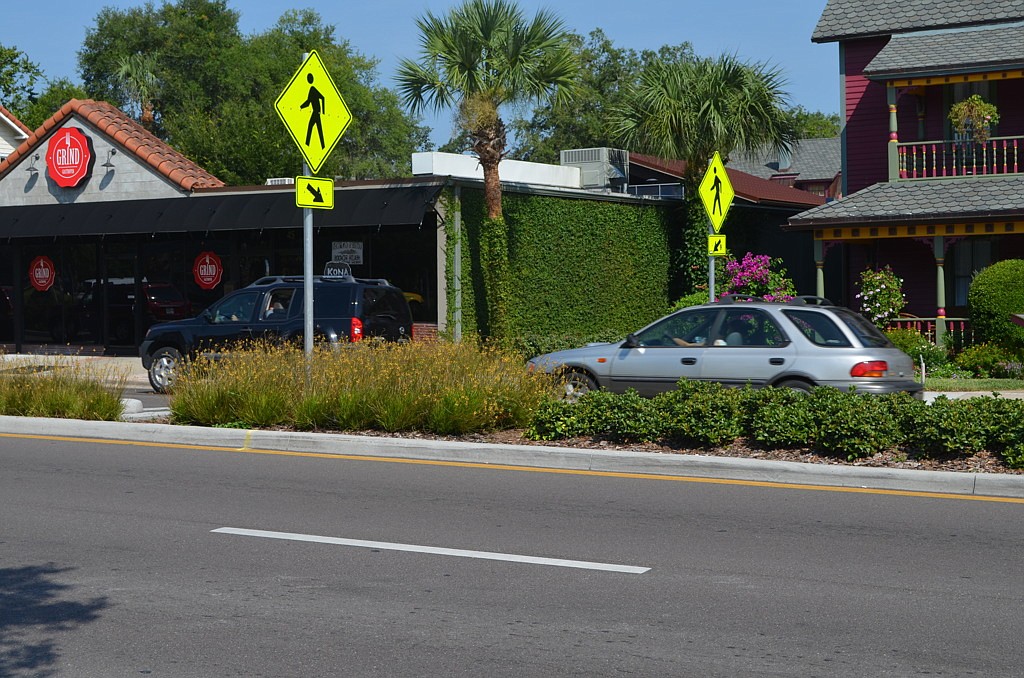- April 25, 2024
-
-
Loading

Loading

City official often sees arguments between drivers and pedestrians
As the pedestrian stepped off the curb at the marked crosswalk, intending to cross the street, the oncoming car came to a stop, allowing him to safely walk across. This is a common occurrence … in some other states. In Florida, not so much.
It’s not that Florida does not have pedestrian crosswalks with signage. It’s just that motorists in this state do not seem to share the awareness they should stop. Pedestrian crosswalks are indicated by the signs shown in the photo.
City Commissioner James Stowers hears and sees conflict daily between drivers and pedestrians, because his law office is located at a pedestrian crosswalk on West Granada Boulevard. He said there needs to be education on the law.
“I go to other places and people know about it but not here,” he said.
People wait in the crosswalk outside his office, hoping for cars to stop, but they often don’t. Stowers sometimes hears them yelling at each other.
It’s a sensitive and dangerous issue, so most city and state officials respond to questions on the matter by citing State Statute 316.130. The complete statute should be read for rules about pedestrian safety and crossing at intersections, etc. The part that deals with pedestrian crosswalks reads:
“(b) The driver of a vehicle at any crosswalk where signage so indicates shall stop and remain stopped to allow a pedestrian to cross a roadway when the pedestrian is in the crosswalk or steps into the crosswalk and is upon the half of the roadway upon which the vehicle is traveling or when the pedestrian is approaching so closely from the opposite half of the roadway as to be in danger.
(c) When traffic control signals are not in place or in operation and there is no signage indicating otherwise, the driver of a vehicle shall yield the right-of-way, slowing down or stopping if need be to so yield, to a pedestrian crossing the roadway within a crosswalk when the pedestrian is upon the half of the roadway upon which the vehicle is traveling or when the pedestrian is approaching so closely from the opposite half of the roadway as to be in danger..
(8) No pedestrian shall suddenly leave a curb or other place of safety and walk or run into the path of a vehicle which is so close that it is impossible for the driver to yield.”
Wanda Tison, spokeswoman for the Pedestrian/Bicycling Safety Resource Center at the University of Florida, said pedestrians stop and wait at a crosswalk, because they want to be sure the cars stop. If a driver sees them, they should stop.
“If a pedestrian has stepped off the curb and into the crosswalk, the car must yield,” she said.
No one should ever step off a curb and assume a car is going to stop. Even if the driver has time to stop, he or she may not be attentive.
Jessica Keane, public information specialist for FDOT, said that it is important for both pedestrians and motorists to exercise caution wherever pedestrians cross roadways.
“While the primary responsibility legally lies with drivers, pedestrians should always be alert for drivers not exercising due caution,” she wrote in an email.
Adding to the danger is that while cars in one lane may stop, cars in another lane may not.
Lt. Jesse Godfrey, of the Ormond Beach Police Department, is aware of the issue. He said he has seen cars traveling through the pedestrian crosswalk on State Road A1A at Standish Avenue as beachgoers waited to cross.
“It’s something we’ve talked about,” he said.
He said any enforcement campaign would likely begin with a public education effort, followed by a period of warnings.